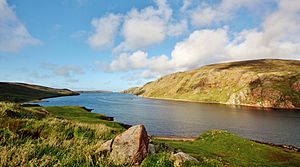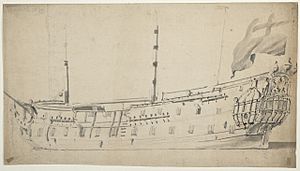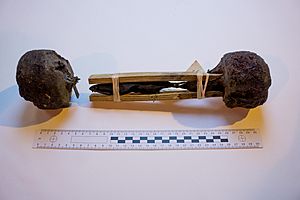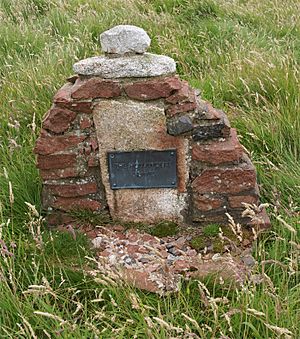Battle of Ronas Voe facts for kids
Quick facts for kids Battle of Ronas Voe |
|||||||
|---|---|---|---|---|---|---|---|
| Part of the Third Anglo-Dutch War | |||||||
 Modern-day view of Ronas Voe |
|||||||
|
|||||||
| Belligerents | |||||||
| Commanders and leaders | |||||||
|
|||||||
| Strength | |||||||
| 1 East Indiaman |
|
||||||
| Casualties and losses | |||||||
|
|
||||||
The Battle of Ronas Voe was a naval fight that happened on March 14, 1674. It took place in Ronas Voe, a narrow inlet in Shetland, Scotland. The battle was between the English Royal Navy and a large Dutch trading ship called Wapen van Rotterdam. This event was part of the Third Anglo-Dutch War.
Interestingly, the battle happened 23 days after a peace treaty, the Treaty of Westminster, had already been signed. This makes it one of the very last battles of that war. The Dutch ship had been forced to take shelter in Ronas Voe because of a severe storm. An unknown person in Shetland told the English authorities about the ship. In response, three English warships were sent to capture it. After a short fight, the Dutch ship was taken. Sadly, up to 300 Dutch crew members were killed during the battle.
Contents
Why the Ship Was There
The Wapen van Rotterdam was a huge trading ship, known as an East Indiaman. It weighed 1,124 tons and carried between 60 and 70 cannons. On December 16, 1673, it left Texel in the Netherlands. Its destination was the Dutch East Indies (modern-day Indonesia). The ship was full of trade goods and carried soldiers from the Dutch East India Company's private army. Its captain was Jacob Martens Cloet.
To avoid the English, who the Dutch were at war with during the Third Anglo-Dutch War, the ship was told to sail north. Instead of going through the English Channel, the plan was to sail around the north of the British Isles. This route was called "going north about" and was common for Dutch East India ships.
However, the ship ran into terrible weather on its journey north. It lost its masts (the tall poles that hold the sails) and its rudder (the part that steers the ship). Strong winds from the south then stopped the ship from being able to pass through the Pentland Firth or the Fair Isle Channel. Because of this, the damaged ship had to find shelter. It sailed into Ronas Voe in the north-west of Mainland, Shetland.
Ronas Voe is a crescent-shaped inlet that offered good protection from the wind. But the ship stayed there for months. This was because of the continuing southerly winds and a lack of wood in Shetland to fix its masts.
Life in Ronas Voe
While stuck in Ronas Voe, the Dutch crew likely traded with the local Shetlanders. They might have exchanged Dutch goods like Hollands gin and tobacco for local foods. These foods included kale, meal, and mutton.
The Shetlanders and Dutch had a lot in common. Many Shetlanders at that time spoke Norn, their native language, but also understood English well. Many were also fluent in Dutch. This was because Dutch ships often traded in Shetland's ports.
At this time, the Kingdoms of England, Ireland, and Scotland all shared the same king, Charles II. This was due to the Union of the Crowns in 1603. So, even though it's called the "Anglo-Dutch War," Scotland was also involved. Shetland, being part of Scotland, was technically at war with the Dutch.
However, the local people in Heylor and nearby areas who met the Dutch crew might not have known about the war. They probably didn't see the Dutch sailors as enemies. Someone who understood the political situation, like a local leader or merchant, must have sent a letter to the English authorities. This letter would have told them about the Dutch ship and its damaged state.
Because of this information, four Royal Navy ships were ordered to sail to Shetland and capture the Wapen van Rotterdam. These ships were HMS Cambridge (captain: Arthur Herbert), HMS Newcastle (captain: John Wetwang), HMS Crown (captain: Richard Carter), and Dove (captain: Abraham Hyatt).
Orders to Attack

Captain Herbert of the Cambridge received his orders first. They came in a letter on February 21, 1674, from Samuel Pepys, a high-ranking official in the Royal Navy. Pepys said the orders came from the King's brother, the Royal Highness. He stressed that the orders needed to be carried out quickly. The peace treaty was expected to be announced soon, and any fighting after that would have to stop within twelve days. In fact, the Treaty of Westminster had already been signed two days before this letter was sent!
The next day, the same orders were sent to Captains Wetwang (Newcastle) and Carter (Crown). Pepys also wrote to Captain Herbert again. He told him that a pilot who knew Shetland's coast would be sent to help. He also confirmed that Crown and Dove would join his ship.
On February 25, Captain Herbert wrote back to Pepys. He said that neither the pilot nor the Dove had arrived yet. Pepys replied on February 28, saying he had sent instructions to hurry the pilot and was checking on the Dove's delay.
On March 3, Captain Taylor, stationed at Harwich, told Pepys that Cambridge and Crown had passed by on their way to Shetland. The same day, Pepys told Captain Carter that his ship had enough food for the crew until they returned from Shetland.
Sadly, on March 6, the Dove was wrecked off the coast of Northumberland while sailing north. This left only the three main warships to continue towards Shetland.
The Battle
Many reports say the battle happened in February 1674. However, the only known report from that time says it happened on March 14, 1674. This was one day after Pepys' original deadline for the mission. It was also 23 days after the Treaty of Westminster had been signed, officially ending the war.
When the English ships Cambridge, Newcastle, and Crown arrived, they sailed into Ronas Voe. A short, one-sided battle quickly began. A single East Indiaman like Wapen van Rotterdam might have had a tiny chance against three more agile warships in the open sea. But in the tight space of Ronas Voe, and likely still without its masts, the Wapen van Rotterdam was completely outmatched.
The English ship Newcastle captured the Wapen van Rotterdam. The Dutch ship was then taken back to England as a prize of war (a captured enemy ship). A Dutch newspaper at the time reported that the Wapen van Rotterdam originally had 400 crew members. Later, only 100 prisoners were being transported by the Crown. This suggests that up to 300 crew members might have been killed. However, other prisoners might have been on the other English ships. Those who died in the battle were buried nearby in Heylor. Both Captain Cloet and the Dutch army captain survived and were taken to England with the rest of the surviving crew.
After the Battle
The Crown took 100 Dutch prisoners aboard. On its way back to England, the ship faced very bad weather. It finally reached Dover on March 29, 1674. Samuel Pepys wrote to Captain Carter on March 31. He said that King Charles II and the Royal Highness were "well pleased" with the success of the Cambridge and Newcastle. The ships returned to the Downs by April 3. Pepys also wrote to Captain Herbert on April 4, passing on a comment from the House of Lords: "Long may the civility which you mention of the Dutch to his Majesty's ships continue."
Captain Wetwang directed the captured Dutch ship to Harwich on April 7, on its way to the River Thames. The remaining Dutch crew were put ashore in Harwich. Captain Cloet and the army captain then sailed back to the Dutch Republic. Before they left, the Dutch captains estimated the value of the Wapen van Rotterdam and its goods at about £50,000. This would be worth millions of pounds today!
In June of the same year, a high-ranking official named Arthur Annesley asked for Captain Wetwang to be given £500 for capturing the ship and bringing it safely to the Thames. This money was supposed to come from selling the goods on the ship.
Letters found on the Wapen van Rotterdam were also captured. They still exist in English archives and some were published in 2014.
Goods for Sale
On May 24, 1674, many of the goods from the captured ship were put up for sale. This happened at the East India House in London. The ship carried a wide variety of items, showing its purpose as a trading vessel. These included different types of cloth (like scarlet and crimson), Amber, various drinks like Hollands beer, Spanish wine, Vinegar, and even Malay language New Testaments and other books. There were also practical items like nails, Twine, sail needles, and tools for carpenters and smiths.
The Ship's New Life
The Wapen van Rotterdam was renamed HMS Arms of Rotterdam. It was changed into an unarmed hulk, which is a ship used for storage or as a base, rather than for sailing or fighting. In 1703, the Arms of Rotterdam was taken apart at Chatham Dockyard.
The Hollanders' Graves
The place where the Dutch sailors killed in the battle were buried is known as the Hollanders' Knowe. A small granite cairn (a pile of stones) marks the site. It has a plaque that reads "The Hollanders' Graves". These graves are likely the first War graves ever recorded in Shetland.




